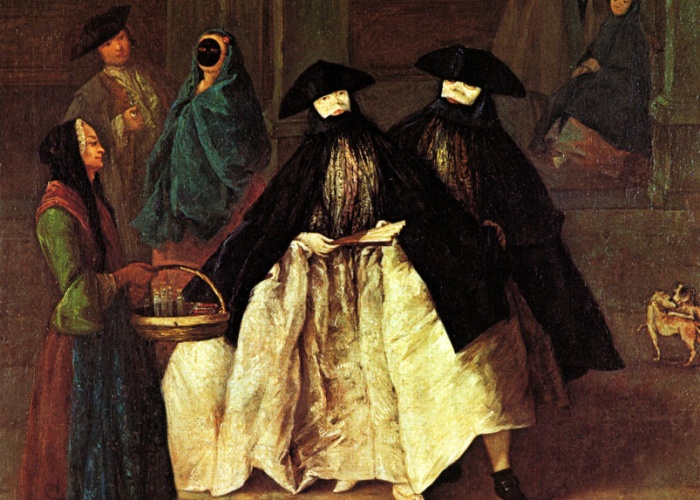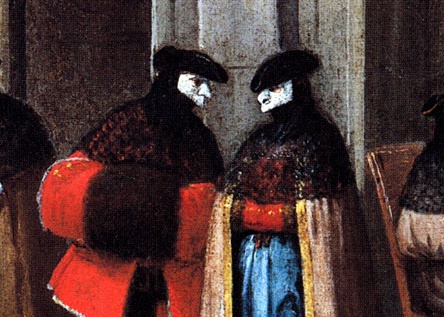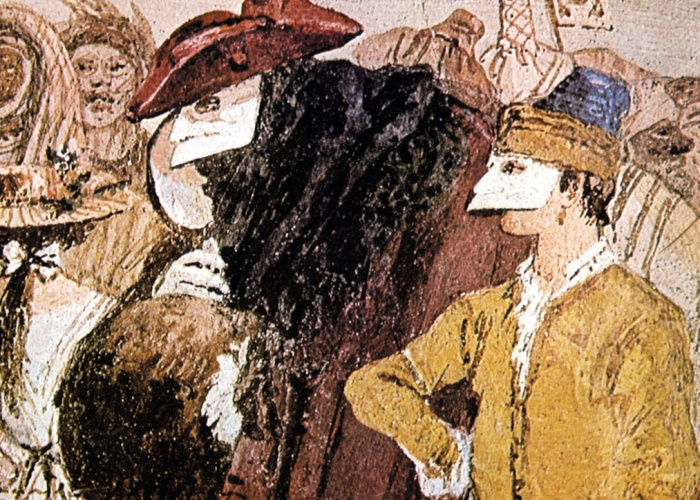Bauta: Queen of Venetian masks
Among the many Venetian carnival masks we produce in our workshop, there is, of course, the bauta, the queen of Venetian masks. Everyone knows that in Venice masks are a famous part of the city's history and culture, and it is widely thought that Venetian masks were simply used for the famous Carnival of Venice. In reality, over the many centuries of the Republic of Venice, Venetian masks - and the bauta mask in particular - had a complex and fascinating history.
 |
Until 1797, when the Republic of Venice ceased to exist, Venetian masks were a major part of everyday life and worn well outside the carnival period. In fact, by law, one could wear a bauta mask for around six months out of the year. One interesting result was that the 'bauta mask ghost' idea perpetuated among foreign travellers who came to believe that Venice was a city 'full of ghosts' with a carnival all year-round.
The extensive use of Venetian masks in everyday life had a straightforward purpose: maintaining anonymity and one's personal freedom. And it was a practice that made Venice a truly unique place in all the world, enriched by a tangible sense of mystery. Imagine, for example, couples in bauta masks chatting with each other in the Piazza San Marco. One masked couple walks into a café for a hot chocolate... you don't know who they are, so you had better be careful with your gossip! Imagine in those days entering the “Ridotto”, the elegant casino immortalized in literature. Around the gaming tables lit by candlelight, you see only people wearing the bauta costume. No one will be able to know whether the heir to a noble family has just been ruined or whether a merchant has won a fortune. The scandal was minimized, jealousy was suppressed: this was how peace in the Republic of Venice was maintained. |
Origins and use of the bauta
|
La The origins of the bauta mask are quite mysterious. But one thing that is known for sure is that like other Venetian masks such as the Mattaccino or the Gnaga, it is very ancient. The first document attesting to the existence of the bauta dates back to the 13th century! Indeed, it was listed among the items on a dowry list, suggesting that it had already been around for some time.
Over the years, the bauta costume became a vital part of the Venetian lifestyle, and one experienced true liberation by wearing it. Class differences were erased as nobles and commoners all blended together behind this special Venetian mask, equally freed by the constraints of public morality. Gambling and vice could be practiced with relative ease, and one's public reputation could be safe whatever one's questionable private pursuits.
|
Class differences were erased as nobles and commoners all blended together behind this special Venetian mask, equally freed by the constraints of public morality. Gambling and vice could be practised with relative ease, and one's public reputation could be safe whatever one's questionable private pursuits.
|
 |
| Yet there are limits to everything, and even though the bauta mask could be worn well outside the Carnival of Venice period, it could not always be relied upon for protection. According to the laws from the later Republic, the bauta costume could only be worn in autumn from 5 October to 16 December; during the major public holidays such as the Festa della Sensa (held on the feast of the Ascension and featuring the special ceremony called the Marriage of the Sea) and to celebrate the election of the doge and other high officials of the Republic of Venice. |
La lThe law officially prohibited wearing the bauta during Lent and other religious festivals, though we know from contemporary accounts that the law was often flouted in favour of wearing the famous Venetian mask. Numerous official decrees by lawmakers with all sorts of restrictions and amendments paint of picture of Venetians trying to wear the bauta whenever possible. Citizens of the Republic of Venice were so used to carrying the bauta around with them that they regarded it as common, even ordinary. |
 |
The daily use of the bauta costume certainly made the bauta mask the queen of all the Venetian masks, distinguishing it from other Venetian carnival masks and Carnival of Venice costumes. These latter were typically work only during the holiday season and were intended to depict a specific character type (a freeloader, a Turk, etc.), and were usually satirical, grotesque, or apotropaic (the plague doctor is a good example). By contrast, the bauta mask became something of a national costume, even an aristocratic uniform. |
During the major celebrations of the political life of the state, in the presence of the Serenissimo Doge, elegant formal wear was combined with the bauta. This reinforced equality and cohesion among individuals and families in the patrician class, especially in the presence of foreign dignitaries. The pretence of harmony was an integral part of the state ideology of the Republic of Venice. |
The bauta truly constitutes a unique event in history: a mask coming out of a festival or ritual and entering the year-round daily life of society across all social classes. There were even cases where wearing a bauta mask was required by law. If you would like to learn more, we invite you to
join our workshop on how to make a bauta mask or buy our book “Venetian Masks” from our online store.
Characteristics of the bauta costume
Historically, the main characteristics of the bauta consist of:
- the bauta proper, i.e. a black silk hood decorated with lace.
- the white mask called the Face.
- a hat, varying in style according to the period.
| |
The bauta, from which the costume gets its name, covers the head and extends down to the elbow. It is formed of two basic parts. The upper part makes the wearer unrecognizable, hiding every possible detail of the head and clothing, with an oval-shaped hole framing the face, obscuring the chin. The lower part fills out the costume with a beautiful display of different types of materials. Those who could afford it used lace, which cost a real fortune. The colour of the bauta was always black without exception. |
| The face itself is hidden by the mask, called in Italian the “volto” (face). In actuality, it is a stylized version of a human face with a very protruding nose allowing you to talk, eat, and drink without ever taking off your mask. It has no laces and is held between the hat and the forehead, remaining suspended and not pressing against the face. This is why the mask could be worn for hours at a time without difficulty. The material used for making the mask was plaster, reinforced by gauze and gesso. This ensured the masks were lightweight and comfortable, but also made them fragile. Today only two original masks survive from the 18th century, kept today at the Metropolitan Museum of Art in New York. |
|
| |
The hat changed according to the fashions of times, but often in the seventeenth and eighteenth centuries one wore the tricorn. When worn in combination with the bauta mask, the tricorn was very comfortable: if one wanted to remove one's 'face' for a moment, one could do so very easily, putting it into a trunk until one wanted to wear it again. This method appears in numerous representations from the period. |
If you too want to try the experience of wearing an authentic Venetian Bauta, you can
come to our shop in the heart of the historic centre of Venice.
The Bauta as Carnival of Venice costume
Today the bauta costume is a symbol and stands out among all the various costumes associated with the Carnival of Venice. Its image can be seen everywhere from tourist stalls at Piazza San Marco to souvenir shops in tiny plastic versions only a few centimeters high. At Ca’ Macana we handcraft our bauta masks exclusively with cartapesta using the original, authentic techniques, creating these wonderful Venetian masks as they appeared so long ago in masterpieces of the period. Take a look at our online shop to see the fine craftsmanship of our Venetian carnival masks for yourself.


